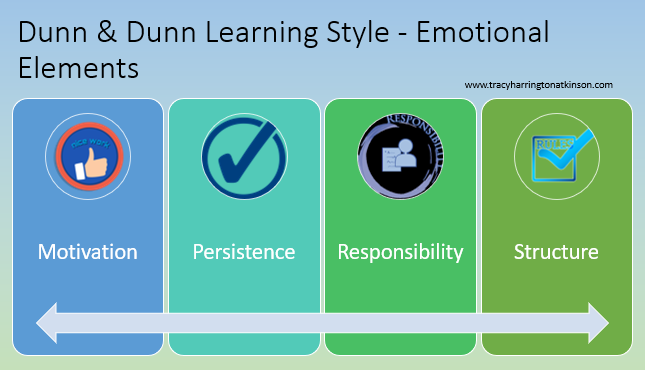
Emotional attributes are related to the motivation, persistence and even the responsibility of the student. Is the student willing to conform to the learning task or more associated with non-conformity? What about patience and structure?

Personalized Learning Inventory – Unlock Your Learning Potential: Discover Your Unique Style with the Dunn & Dunn Personalized Learning Assessment is a comprehensive guide that helps readers identify their individual learning preferences using the Dunn & Dunn model. This book provides an insightful assessment that allows learners to better understand their unique learning styles, focusing on key areas such as environmental, emotional, sociological, physiological, and psychological factors.
Motivation
Motivation is a lengthy and interesting topic. Motivation actually exists on a spectrum from amotivation to extrinsic to intrinsic.
Often the mistake is made that motivation stays the same – between students and within an individual student. However, it is important to recognize that an individual who may seem completely unmotivated will be highly motivated in a different circumstance. For example, maybe a student will appear highly unmotivated to a math teacher but the English teacher will find the same student to be highly motivated.
Motivation may also change according to the time of day or the type of activity. How often have you witnessed a highly motivated student who is excited about learning to immediately become unmotivated when asked to work with a partner or in a group?
Motivation can be highly tricky to identify, initialize and maintain. The trick is to know yourself and the student well. Identify what situations energize and mobilize the student. Then identify what disanimates them.
Persistence
Persistence is simply the ability to start a task and follow through with it until it is completed. If a student has a shorter attention span, their persistence will be low. Low persistence is also attributed to any activities that may be too challenging. Activities that are too challenging lead to a loss of interest, irritation, daydreaming, distractions, socializing and more. The same list of results can be attributed to any activity that may be too simple for the student. This is referring to the Zone of Proximal Development. As every educator knows, creating activities within the realm of the ability of the student can be difficult.
The pace of the assignment is also part of persistence. If the activity moves too quickly or too slowly will affect persistence. The greatest solution for this problem is to create self-pacing activities for students. Self-pacing allows students to have more or less time to address the tasks according to their talents, interests, abilities and even learning styles.
Giving objectives aids students in developing and maintaining persistence. The student then will understand the importance of what they are learning and the purpose.
Note that like motivation, persistence will change according to the type of activity, learning environment, etc. It requires constant trial and error by the educator. To determine the best practices to work within that Zone of Proximal Development and identify the persistence level of the student, the educator should take a period of time to observe the student. Start at a simpler activity and gradually increase the complexity and duration of activity.
Responsibility
Responsibility is simply the learner following through with a given task, completing it to the best of their ability and within the given timeframe.
Dunn and Dunn (1978) suggest that responsible students need:
- A clearly stated assignment
- Resources
- Time frame
- List of where to get help or assistance
- Suggestions on how to test their knowledge
- Alternative ways to demonstrate they’ve achieved the learning objectives (p10)
Structure
“Structure is the establishment of specific rules for working on and completing an assignment” (Dunn & Dunn, 1978, p11). What would these rules entail? Simply these are the instructions for the assignment including what it is, the objectives, how to complete it and the due date.
Structure contributes to the learning personality by determining the mode by which the student wants guidance. Some students will want more guidance and structure for each assignment. This type of learning is quickly identified by observing and listening after an assignment has been given. Do they ask more clarifying questions? Do they ask their classmates for more guidance? Do they look to see what others are doing?
The opposite also exists – the student who needs less structure. This type of learner will want the independence to determine their rules and possess the freedom of choice and creativity.
Think of structure like a spectrum of a desire to have substantial guidance (more dependent upon the authority figure and others) to having less guidance (more independent and needing the autonomy to be creative).
Conclusion
The student who is more motivated, persistent and responsible is going to require less structure in their assignments and also less supervision. In contrast, the unmotivated, irresponsible and lacking persistence will require more structure and guidance. Through experience, the educator will gain insights which will guide the students through this learning process.
Sources:
Dunn, R. & Dunn, K. (1978). Teaching Students Through Their Individual Learning Styles: A Practical Approach. Allyn and Bacon.
Subscribe to our YouTube Channel by clicking here.

Comments are closed